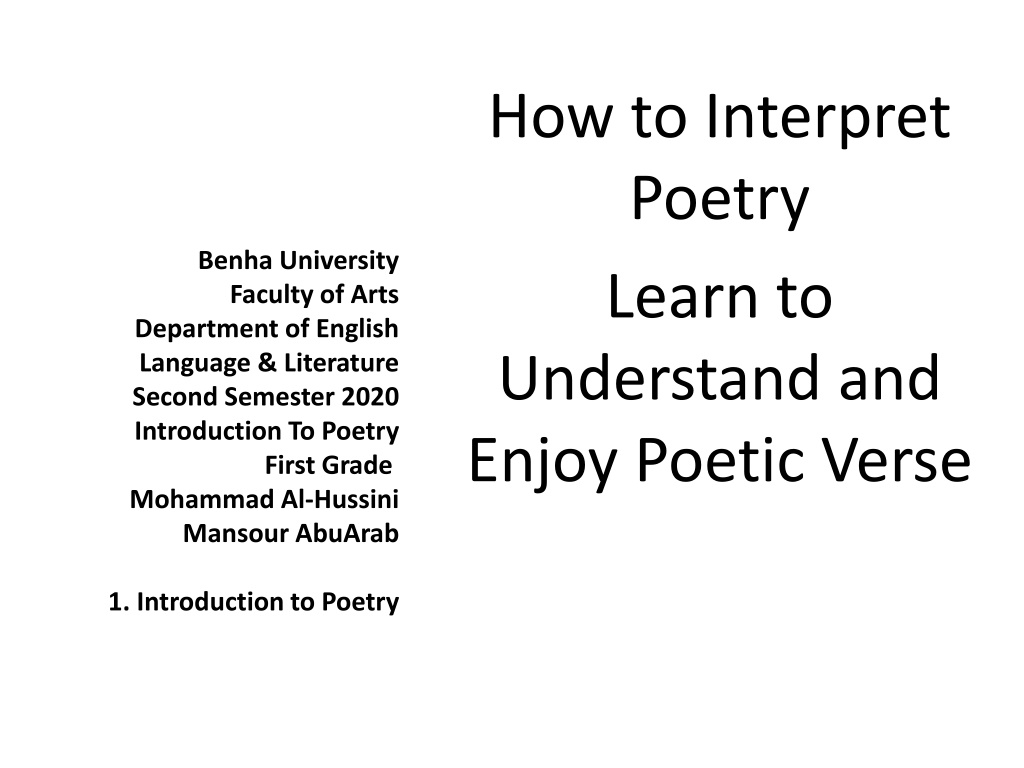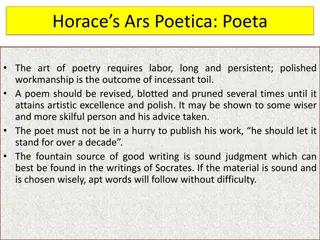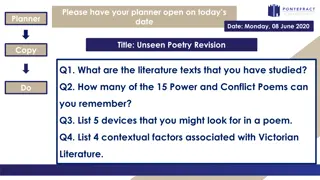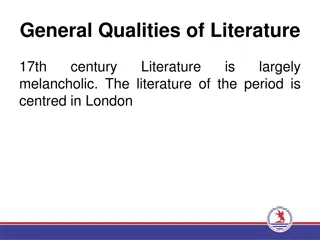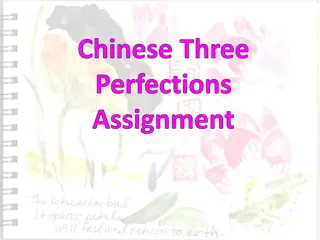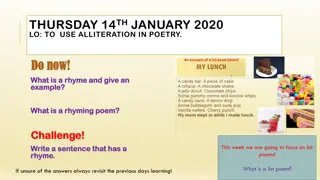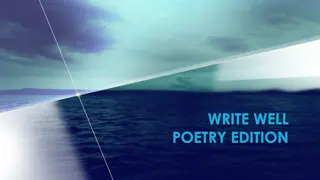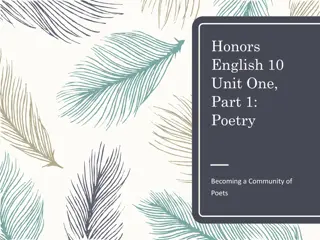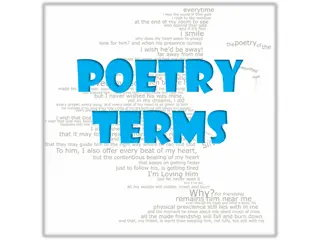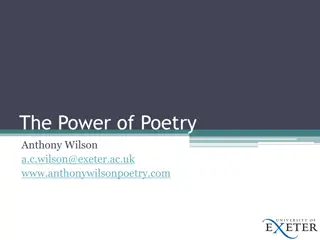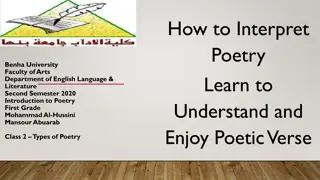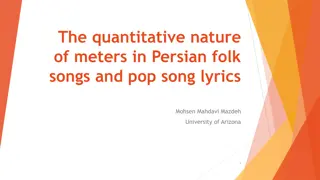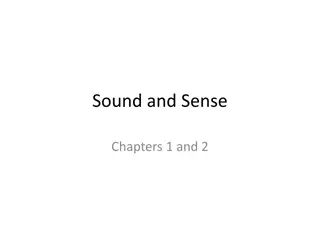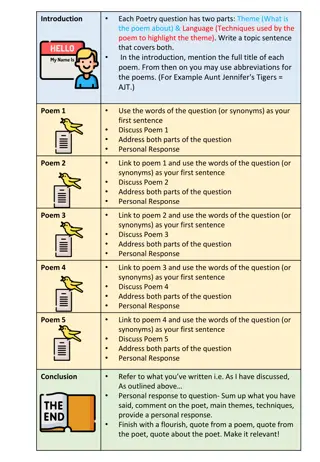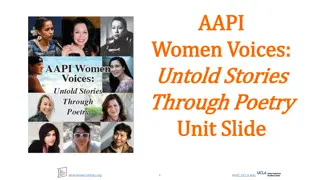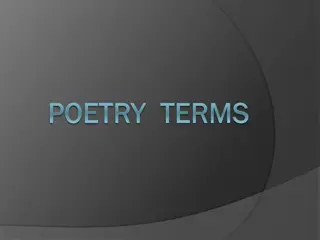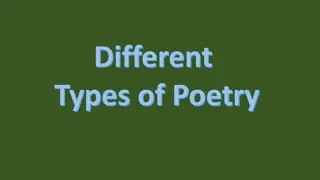Understanding Poetry: Techniques and Examples
Dive into the world of poetry interpretation with this guide, exploring various poetic devices such as end rhyme, internal rhyme, alliteration, and onomatopoeia. Learn how these techniques add depth and creativity to verses, enhancing your appreciation and understanding of poetic artistry.
Download Presentation

Please find below an Image/Link to download the presentation.
The content on the website is provided AS IS for your information and personal use only. It may not be sold, licensed, or shared on other websites without obtaining consent from the author. Download presentation by click this link. If you encounter any issues during the download, it is possible that the publisher has removed the file from their server.
E N D
Presentation Transcript
How to Interpret Poetry Learn to Understand and Enjoy Poetic Verse Benha University Faculty of Arts Department of English Language & Literature Second Semester 2020 Introduction To Poetry First Grade Mohammad Al-Hussini Mansour AbuArab 1. Introduction to Poetry
The repetition of sounds End rhyme- the last word on each line rhymes. Example: hat, cat, brat, fat, mat, sat My Beard by Shel Silverstein My beard grows to my toes, I never wears no clothes, I wraps my hair Around my bare, And down the road I goes. Internal rhyme- Words INSIDE the sentence rhyme.
The repetition of the initial letter or sound in two or more words in a line. To the lay-person, these are called tongue-twisters . Example: How much dew would a dewdrop drop if a dewdrop did drop dew?
Lets see what this looks like in a poem. Alliteration Alliteration She Walks in Beauty I. She walks in beauty, like the night Of cloudless climes and starry skies; And all that s best of dark and bright Meet in her aspect and her eyes: Thus mellowed to that tender light Which Heaven to gaudy day denies. Alliteration These examples use the beginning sounds of words only twice in a line, but by definition, that s all you need.
Words that spell out sounds; words that sound like what they mean. Examples: growl, hiss, pop, boom, crack, ptthhhbbb.
Lets see what this looks like in a poem. Noise Day by Shel Silverstein Let s have one day for girls and boyses When you can make the grandest noises. Screech, scream, holler, and yell Buzz a buzzer, clang a bell, Onomatopoeia Sneeze hiccup whistle shout, Laugh until your lungs wear out, Toot a whistle, kick a can, Several other words not highlighted could also be considered as onomatopoeia. Can you find any? Bang a spoon against a pan, Sing, yodel, bellow, hum, Blow a horn, beat a drum, Rattle a window, slam a door, Scrape a rake across the floor . . ..
A comparison between two usually unrelated things using the word like or as . Examples: Joe is as hungry as a bear. In the morning, Rae is like an angry lion.
Ars Poetica By Archibald MacLeish A poem should be palpable and mute as a globed fruit, Silent as the sleeve-worn stone Of casement ledges where the moss has grown A poem should be wordless As the flight of birds. Simile Simile Let s see what this looks like in a poem. Simile
An implied comparison between two usually unrelated things. Examples: Lenny is a snake. Ginny is a mouse when it comes to standing up for herself. The difference between a simile and a metaphor is that a simile requires either like or as to be included in the comparison, and a metaphor requires that neither be used.
When it comes to using a metaphor device in poetry, a poet can either make the entire poem a metaphor for something, or put little metaphors throughout the poem. The following poem is one big metaphor.
An exaggeration for the sake of emphasis. Examples: I may sweat to death. The blood bank needs a river of blood.
Giving human characteristics to inanimate objects, ideas, or animals. Example: The sun stretched its lazy fingers over the valley.
What is Symbolism? A symbol is something that stands for itself, but also something larger than itself. It may be a person, an animal, an inanimate object, or an action . A writer often uses a concrete object to express an abstract idea, a quality, or a belief. A symbol may appeal to a reader's emotions and can provide a way to express an idea, communicate a message, or clarify meaning
What is Symbolism? A writer often uses a concrete object to express an abstract idea, a quality, or a belief. A symbol may appeal to a reader's emotions and can provide a way to express an idea, communicate a message, or clarify meaning.
Mother to Son by Langston Hughes Well, son, I'll tell you: Life for me ain't been no crystal stair. It's had tacks in it, And splinters, And boards torn up, And places with no carpet on the floor -- Bare. But all the time I'se been a-climbin' on, And reachin' landin's, And turnin' corners, And sometimes goin' in the dark Where there ain't been no light. So boy, don't you turn back. Don't you set down on the steps 'Cause you finds it's kinder hard. Don't you fall now -- For I'se still goin', honey, I'se still climbin', And life for me ain't been no crystal stair.
Using words to create a picture in the reader s mind.
Poetry that follows no rules. Just about anything goes. This does not mean that it uses no devices, it just means that this type of poetry does not follow traditional conventions such as punctuation, capitalization, rhyme scheme, rhythm and meter, etc. Fog The fog comes on little cat feet. No Rhyme No Rhythm No Meter It sits looking over harbor and city This is free verse. on silent haunches and then, moves on.
A reference to another piece of literature or to history. Example: She hath Dian s wit (from Romeo and Juliet). This is an allusion to Roman mythology and the goddess Diana. The three most common types of allusion refer to mythology, the Bible, and Shakespeare s writings.
Rhythm Rhythm is the flow of the beat in a poem. Gives poetry a musical feel. Can be fast or slow, depending on mood and subject of poem. You can measure rhythm in meter, bycounting the beats in each line.
Rhythm Example The Pickety Fence by David McCord The pickety fence The pickety fence Give it a lick it's The pickety fence Give it a lick it's A clickety fence Give it a lick it's a lickety fence Give it a lick Give it a lick Give it a lick With a rickety stick pickety pickety pickety pick. The rhythm in this poem is fast to match the speed of the stick striking the fence. 21
Rhythm Example Where Are You Now? When the night begins to fall And the sky begins to glow You look up and see the tall City of lights begin to grow In rows and little golden squares The lights come out. First here, then there Behind the windowpanes as The rhythm in this poem is slow to match the night gently falling and the lights slowly coming on. 22
Imagery Imagery is the use of words to create pictures, or images, in your mind. Appeals to the five senses: smell, sight, hearing, taste and touch. Details about smells, sounds, colors, and taste create strong images. To create vivid images writers use figures of speech. Five Senses 23
Lines and Stanzas March Most poems are written in lines. A group of lines in a poem is called a stanza. Stanzas separate ideas in a poem. They act like paragraphs. This poem has two stanzas. A blue day A blue jay And a good beginning. One crow, Melting snow Spring s winning! By Eleanor Farjeon 24
Free Verse Revenge A free verse poem does not use rhyme or patterns. Can vary freely in length of lines, stanzas, and subject. When I find out who took the last cooky out of the jar and left me a bunch of stale old messy crumbs, I'm going to take me a handful and crumb up someone's bed. 25 By Myra Cohn Livingston
Mood Mood is the atmosphere, or emotion, in the poem created by the poet. Can be happy, angry, silly, sad, excited, fearful or thoughtful. Poet uses words and images to create mood. Author s purpose helps determine mood. (See slides 65-72 for examples.) 26
Mood - Barefoot Days Barefoot Daysby Rachel Field In the morning, very early, That s the time I love to go Barefoot where the fern grows curly And grass is cool between each toe, On a summer morning-O! On a summer morning! That is when the birds go by Up the sunny slopes of air, And each rose has a butterfly Or a golden bee to wear; And I am glad in every toe Such a summer morning-O! Such a summer morning! The mood in this poem is happy. What clues in the poem can you use to determine the mood? 27
Mood - Mad Song Mad Song I shut my door To keep you out Won t do no good To stand and shout Won t listen to A thing you say Just time you took Yourself away I lock my door To keep me here Until I m sure You disappear. The mood in this poem is angry. What clues in the poem can you use to determine the mood? 28
Mood - Poem Poem I loved my friend. He went away from me. There s nothing more to say. The poem ends, Soft as it began I loved my friend: By Langston Hughes The mood in this poem is sad. What clues in the poem can you use to determine the mood? 29
Diction Diction refers to the language of a poem, and how each word is chosen to convey a precise meaning. Poets are very deliberate in choosing each word for its particular effect, It's important to know the denotation and connotations of the words in a poem, not to mention their literal meaning, too. 30
Diction Example: T.S. Eliot, "Burnt Norton "Words strain, Crack and sometimes break, under the burden, Under the tension, slip, slide, perish, Decay with imprecision, will not stay in place, Will not stay still. Notice the choice of harsh words like burden and strain . 31
Tone. Tone is the attitude writers take towards their subject . Would this poem have a different meaning for the reader if the tone was changed?
There s This that I like About Hockey, My Lad by John Kieran (continued) old chap There s this that I like about hockey There s this that I like about hockey, old chap; I think you ll agree that I m right; Although you may get an occasional rap, There s always good fun in the fight. So toss in the puck, for the players are set; Sing ho! For the dash on the enemy net; And ho! For the smash as a challenge is met; And hey! For a glorious night! glorious night Author s Attitude towards Hockey Author is speaking to good fun enemy net
Dont Confuse Tone & Mood! *Tone and mood are two different aspects of a poem! * Tone is the author's or the poet's attitude towards his or her subject. *Mood is how the poem makes the reader or the listener feel.
Reading for Meaning To find meaning in a poem, readers ask questions as they read. There are many things to pay attention to when reading a poem: Title Provides clues about topic, mood, speaker, author s purpose? Rhythm Fast or slow? Why? Sound Devices What effects do they have? Imagery What pictures do we make in our minds? Figures of Speech What do they tell us about the subject? Voice Who is speaking - poet or character; one voice or more? Author s Purpose Sending message, sharing feelings, telling story, being funny, being descriptive? Mood Happy, sad, angry, thoughtful, silly, excited, frightened? Plot What is happening in the poem? Remember, to make meaning, readers must make connections and tap into their background knowledge and prior experiences as they read. 35
